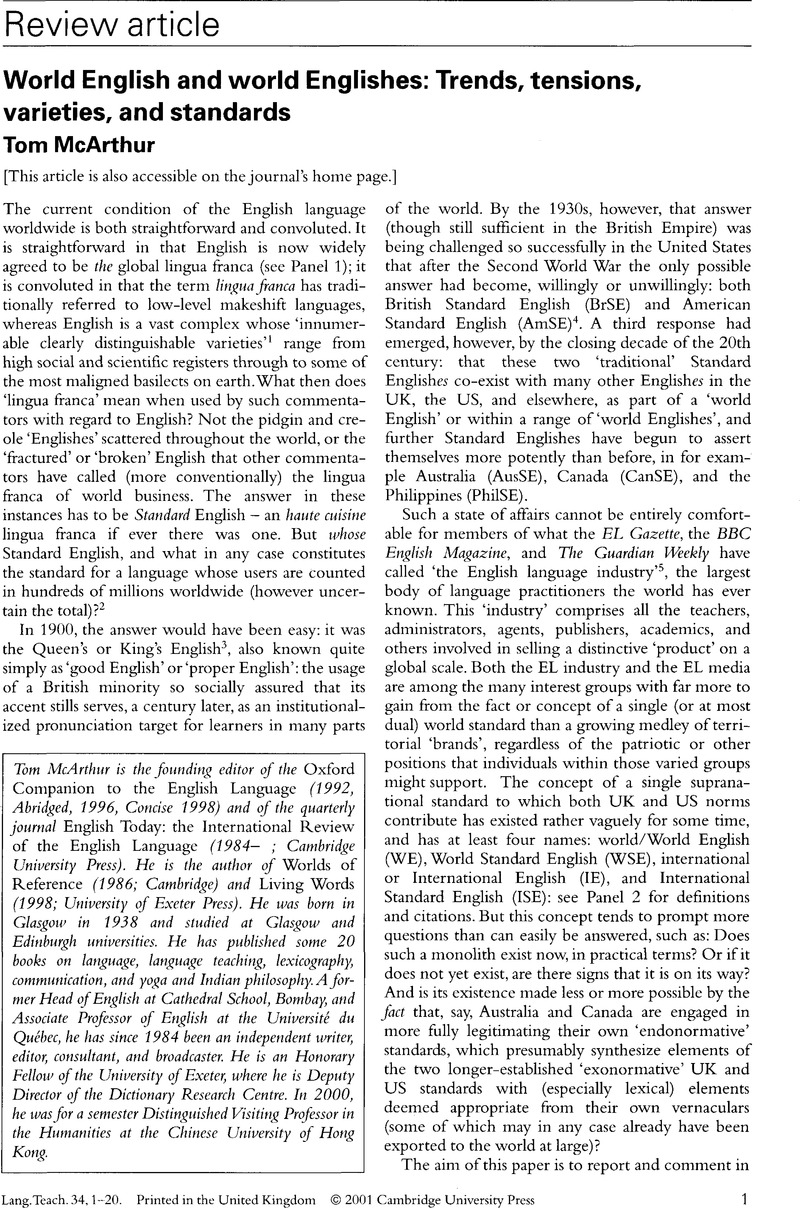Crossref Citations
This article has been cited by the following publications. This list is generated based on data provided by Crossref.
Bolton, Kingsley
2004.
The Handbook of Applied Linguistics.
p.
367.
Peters, Pam
2004.
The Cambridge Guide to English Usage.
Seferoglu, Gölge
2004.
A study of alternative English teacher certification practices in Turkey.
Journal of Education for Teaching,
Vol. 30,
Issue. 2,
p.
151.
Mukherjee, Joybrato
2007.
Steady States in the Evolution of New Englishes.
Journal of English Linguistics,
Vol. 35,
Issue. 2,
p.
157.
Peters, Pam
2008.
International English and its construction.
Australian Review of Applied Linguistics,
Vol. 31,
Issue. 3,
p.
35.1.
Peters, Pam
2008.
International English and its construction.
Australian Review of Applied Linguistics,
Vol. 31,
Issue. 3,
p.
35.1.
KACHRU, YAMUNA
and
SMITH, LARRY E.
2009.
The Karmic cycle of world Englishes: some futuristic constructs.
World Englishes,
Vol. 28,
Issue. 1,
p.
1.
Young, Tony Johnstone
and
Walsh, Steve
2010.
Which English? Whose English? An investigation of ‘non-native’ teachers' beliefs about target varieties.
Language, Culture and Curriculum,
Vol. 23,
Issue. 2,
p.
123.
Boyle, Ronald
2011.
Patterns of change in English as a lingua franca in the UAE.
International Journal of Applied Linguistics,
Vol. 21,
Issue. 2,
p.
143.
강성숙
and
이상기
2012.
A Survey of Korean English Teachers’ Perceptions and Attitudes about the Common Features of English as a Lingua Franca: Focusing on the Lexical and Grammatical Features.
Korean Journal of English Language and Linguistics,
Vol. 12,
Issue. 3,
p.
379.
Park, Gloria
2012.
“I Am Never Afraid of Being Recognized as an NNES”: One Teacher's Journey in Claiming and Embracing Her Nonnative‐Speaker Identity.
TESOL Quarterly,
Vol. 46,
Issue. 1,
p.
127.
Berns, Margie
2012.
The Encyclopedia of Applied Linguistics.
Quayson, Ato
2012.
The Cambridge History of Postcolonial Literature.
Rajagopalan, Kanavillil
2012.
‘World English’ or ‘World Englishes’? Does it make any difference?.
International Journal of Applied Linguistics,
Vol. 22,
Issue. 3,
p.
374.
Feng, Anwei
2012.
Spread of English across Greater China.
Journal of Multilingual and Multicultural Development,
Vol. 33,
Issue. 4,
p.
363.
Park, Gloria
and
Henderson Lee, Sarah
2014.
Critical Perspectives on World Englishes: An Inquiry into Our Disciplinary Spaces as Teacher–Scholars.
TESOL Journal,
Vol. 5,
Issue. 3,
p.
395.
Shen, Huizhong
Yuan, Yifeng
and
Ewing, Robyn
2015.
English learning websites and digital resources from the perspective of Chinese university EFL practitioners.
ReCALL,
Vol. 27,
Issue. 2,
p.
156.
2015.
Pronunciation Fundamentals.
Vol. 42,
Issue. ,
2015.
The Lexis and Lexicogrammar of Sri Lankan English.
Vol. G54,
Issue. ,
Moeller, Aleidine J.
and
Catalano, Theresa
2015.
International Encyclopedia of the Social & Behavioral Sciences.
p.
327.





